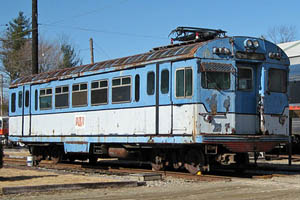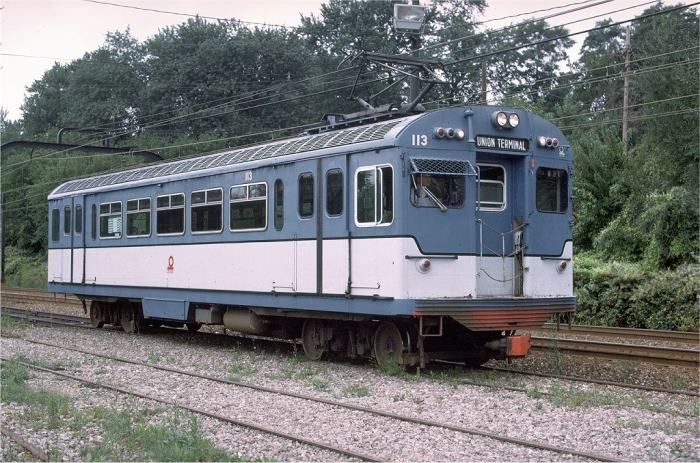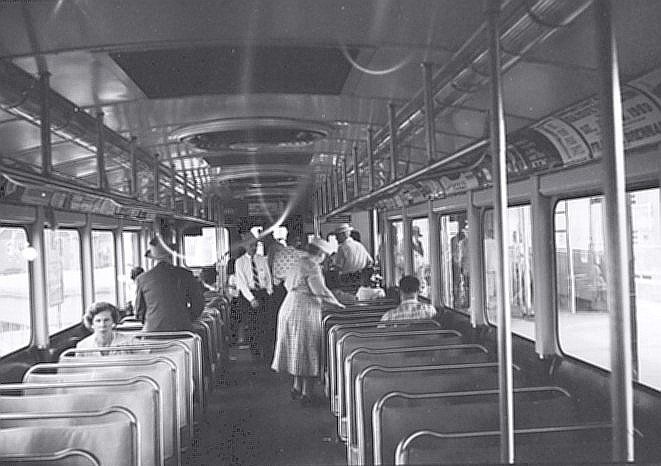
- Builder
- St. Louis Car Co.
- Description
- PCC Rapid Transit
- Secondary Use
- None
- Type
- Rapid Transit Cars
- Year
- 1958
- Retired from Service
- 1984
- Acquired by the Museum
- 2009
- Note
- No. 113 has been stored outdoors and suffers from body deterioration.
- Fund
- 637
Greater Cleveland Regional Transit Authority 113
From Cleveland, Ohio
History
As of the mid-1950s, the four rapid transit systems existing in the U.S. had all evolved from elevated railways opened prior to 1925. In 1955, the city-owned Cleveland Transit System opened the first all-new rapid transit line in the U. S. since the 1920s. The “Rapid” line initially ran between Windermere, on Cleveland’s East Side, and Cleveland Union Terminal. The original CTS rapid transit cars were called “Bluebirds” because of their blue and silver paint scheme. Clevelanders sometimes less-fondly called them “Spam Cans.” Cleveland figured that off peak riding would be light and therefore provided for single car operation. The original fleet consisted of 56 cars operated in pairs and 13 cars (numbers 100-112) operated as single cars. In 1958, CTS extended the line to West Park and purchased another 14 paired cars and six singles (numbers 113-118). The single cars were no longer than the cars designed for the elevated lines in Boston and Chicago, but were 10’ 4” wide, comparable with the most modern lines in those cities. The “Bluebirds” were almost identical to the cars built by St. Louis Car for Boston’s Blue Line in 1951. The cars collected power through roof mounted pantographs. Like the 1951 Boston cars and the Chicago 1958 cars, St. Louis Car used PCC technology to a great extent in the Cleveland cars.
CTS continued to extend its rapid transit line west, reaching Cleveland Hopkins Airport in 1968. Cleveland became the first U.S. city to connect its airport to downtown with rail rapid transit. With the airport expansion, the CTS purchased longer, “Airporter” cars and relegated the Bluebirds to just rush hour service. In 1975, the Cleveland Transit System was expanded to include suburban bus lines and became the Greater Cleveland Regional Transit Authority (RTA). The RTA fully retired the Bluebird cars in 1985 in favor of new equipment.
The Gerald E. Brookins Museum of Electric Railways (known as Trolleyville, U.S.A.), a museum in Ohio, acquired No. 113 when Cleveland retired the car. Trolleyville U.S.A. closed down in 2005 and put its collection of 31 vehicles into storage. Seashore acquired No. 113 when the Trolleyville collection was auctioned off in 2009. In the same auction, Seashore acquired Cleveland Railways trailer car No. 2365. No. 113 joined the similar Boston Blue Line cars Nos. 0559 and 0562 already at Seashore. Seashore has not yet equipped No. 113 with trolley poles for operation at the museum.
Technical Information
- Seats: 52
- Control: Westinghouse XDA1C(C-1)
- Brakes: SMEE
- Compressor: 3YC
Trucks
- Number: 2
- Manufacturer: General Steel
- Model: 70
Motor
- Number: 4
- Manufacturer: Westinghouse
- Model: 1432H
Weight and Dimensions
- Length: 48’ 6.00"
- Width: 10’ 4.00"
- Height: 11’ 9.00"
- Weight: 57050 lbs.
Additional Images

Joe Testagrose collection at newdavesrailpix.com

Interior of sister car 112 – W. Rodgers collection at newdavesrailpix.com
© 1998 - 2025 New England Electric Railway Historical Society. All Rights Reserved.